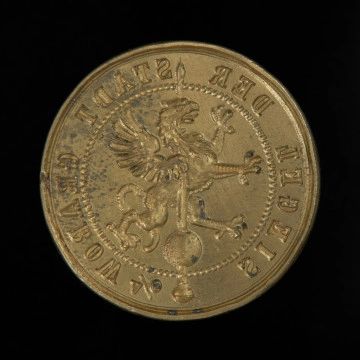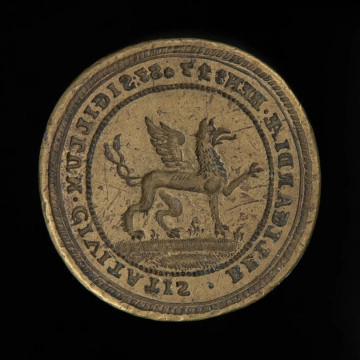
Stamp piston
1856 — 1900
National Museum in Szczecin
Part of the collection: Seals of Pomeranian cities
After the end of the Griffin dynasty and the Thirty Years' War, the area of the Duchy of Pomerania was divided between Sweden and Brandenburg in 1654. The capital of the duchy, along with the neighbouring territories, were taken over by Sweden. However, the Brandenburg rulers treated this division as temporary, and wanted to drive the Swedes out of Pomerania and to incorporate Szczecin into their state. They made their first attempt in 1659. This is commemorated by the city seal of Szczecin from 1660. Carefully engraved in bronze, the seal features a field with a crowned municipal coat of arms with lions to its sides. The whole is surrounded by a laurel wreath. The seal field is separated from the inscription around the rim by two concentric circles, one continuous and the other consisting of a series of trefoils. The outer border near the edge of the seal is also a laurel wreath. The lions, as well as the crown above the escutcheon – previously unused in Pomeranian heraldry – were taken from Swedish state heraldry. Szczecin received the right to decorate its coat of arms with such elements from the Swedish king Charles X Gustav (1622-1660). This was the token of appreciation for the city’s support of the Swedish side, as well as its heroic defence against the Brandenburg and Imperial armies in 1569. The laurel wreath symbolised this victory and had a strong symbolic meaning. In the years 1676 and 1677 Elector of Brandenburg Frederick William I (1620-1688) laid siege to Szczecin twice more, and the city eventually surrendered in 1678. Before a year had passed, the Elector had to return the city to Sweden. Eventually, the Hohenzollern dynasty bought Szczecin together with the surrounding lands in 1720.
Mieszko Pawłowski
laurel wreaths
coat of arms of Szczecin
Swedish Pomerania, historical dependent territory (Western Pomerania)
Electorate of Brandenburg, historic state (Germany)
bronze
seal (artifact)
Charles X Gustav, King of Sweden (1622-1660)
Kingdom of Sweden (historical state)
House of Hohenzollern
Frederick William, elector of Brandenburg and duke of Prussia (1620-1688)
Other names
Bronzener Siegelstempel
Author / creator
Dimensions
cały obiekt: height: 29.6 mm, width: 51.2 mm
Object type
seal
Technique
casting, fine detail finishing, punching, carving
Material
bronze
Creation time / dating
Creation / finding place
Owner
National Museum in Szczecin
Identification number
Location / status
laurel wreaths
coat of arms of Szczecin
Swedish Pomerania, historical dependent territory (Western Pomerania)
Electorate of Brandenburg, historic state (Germany)
bronze
seal (artifact)
Charles X Gustav, King of Sweden (1622-1660)
Kingdom of Sweden (historical state)
House of Hohenzollern
Frederick William, elector of Brandenburg and duke of Prussia (1620-1688)

Miasto Grabowo
1856 — 1900
National Museum in Szczecin

Miasto Białogard
1787
National Museum in Szczecin

Miasto Gryfice
koniec XVIII wieku
National Museum in Szczecin
DISCOVER this TOPIC
Castle Museum in Łańcut
DISCOVER this PATH
Educational path
0/500

We use cookies to make it easier for you to use our website and for statistical purposes. You can manage cookies by changing the settings of your web browser. More information in the Privacy Policy.
We use cookies to make it easier for you to use our website and for statistical purposes. You can manage cookies by changing the settings of your web browser. More information in the Privacy Policy.
Manage cookies:
This type of cookies is necessary for the website to function. You can change your browser settings to block them, but then the website will not work properly.
WYMAGANE
They are used to measure user engagement and generate statistics about the website to better understand how it is used. If you block this type of cookies, we will not be able to collect information about the use of the website and we will not be able to monitor its performance.